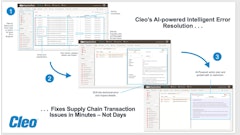
Supply chain issues have been a regular topic in the news since the COVID-19 pandemic shook the manufacturing industry to its core. Smaller manufacturing companies have been bearing the brunt of these issues. Workforce shortage, logistics issues and massive price increases have impacted everyone, and small manufacturers engaged in custom batch production has suffered even more than others. They often lack the resources that are required to be dedicated to supply chain management. Due to limited connectivity to business operations and less structured planning, the supply chain remains a challenge for many manufacturers.
Problems arose because many organizations use just-in-time inventory management and keep minimal inventory on hand, relying on a streamlined production and delivery process to meet customer demand. Others maintain low inventory due to budget issues combined with less than best practices for tracking order lead times. Order processes were also often not documented effectively, so when delivery times for important materials began to lengthen, what resulted was a crisis.
These challenges can be alleviated with wholly embracing the tried-and-true methods for effective supply chain management. Most organizations don’t spend the time and resources to really manage their supply chain. However, a few operating changes to add structure to the process as well as an inventory management process can make a big difference without spending a great deal of money or hiring a bunch of new people. Effective processes, measurements and accountability are the key to a supply chain that works for an organization.
Inventory Management
A great place to start is to study the supply chain, which means taking an honest and close look at business operations. Silos are one of the biggest blocks to an effective supply chain, so focusing on communication is key. Communicate with everyone in the process: supplier, customers and any other stakeholders. When you are aware of the inner workings of the supply chain, any fluctuations will provide an opportunity pivot and retain control of inventory even with disruptions. Some things that every company should do to help manage and plan for changes in inventory include:
- Self-assessment: A supply chain self-assessment will provide a clear beginning to end look at the supply chain. Be sure this assessment includes suppliers, production, and channel visibility. This will provide everyone with an in-depth look at the company’s current process but also weaknesses that could be improved in order to create a more effective system, as well as ways to measure performance.
- Forecast accuracy: Sales, inventory and operations planning (SIOP) is a great way for manufacturers of all sizes to look at their budgeting and forecasting efforts. This plan will provide structure and will take a snapshot of how the projections align with company goals, impact on production capacity and material requirements. This plan can be adjusted as conditions change and will keep everyone focused on the same goal.
- Inventory segmentation: The most effective way to do this is by using the ABC system, which involves identifying parts with the most importance (A) and those with the least importance (C). Different inventory management processes will be needed for each. “A” products have the most value and should be prioritized accordingly. It is important to make sure the inventory is accurate by doing regular cycle counts. A way to do this might be to count “A” parts monthly, “B” parts quarterly and “C” parts twice per year.
Supplier Relations
This is more important than most companies realize because it reveals weaknesses, but it can be the start of staged planning. Begin by gathering data on every part of an organization’s purchases so there is a clear picture of what needs improvement. Look at the supplier’s lead time from order to arrival – do they deliver on time for the most part? Data to be collected includes transportation time, freight costs, quality of items and whether they can adjust to changes in orders or schedules. Some tools to implement when it comes to supplier relations include:
- Supplier scorecard: This is all about evaluating the supplier’s performance from order to delivery. When measuring each supplier’s performance, it can be decided if this supplier is meeting expectations or if an alternate supplier may be needed.
- Total cost of ownership (TCO): This offers a complete perspective on the cost of sourced material. When calculating TCO, include overhead expenses, risks (which could be lost sales and poor customer experience) and any other business considerations, whether they be internal or external.
- Strategic sourcing matrix: Utilizing this will allows an organization to create efficiency, while managing risks across the entire supply chain. It also provides the information to be able to categorize products in terms of profit contribution and supply chain risk – and how all of this impacts the organization.
Vetting Suppliers
One of the biggest challenges for most manufacturers is to find the suppliers that are most closely aligned to them. With day-to-day operations taking precedence, not much attention is spent on vetting suppliers. Instead of taking a reactive approach when it comes to suppliers, it is important to take a proactive approach. When there is a clear understanding of each supplier, quality control can be better managed, as well as flexibility and time to market – all while lowering supply chain risk to an organization.
Some tools that will help locate and vet potential suppliers include:
- Supplier scouting: This program, created by the MEP National Network can be applied on a local, regional or national scale. It will help organizations identify manufacturers with specific production and technical capabilities and connect them to supply chains of other companies or government agencies. There is no cost for this program.
- PESTLE analysis: Political, Economic, Social Technological, Legal and Environmental. This analysis looks at all external factors that could have an impact on a supply chain. When conducting in-depth research on potential suppliers and revealing a clear understanding of potential risks, risks can be better managed.
Plan and Prioritize
This is where an organization sets key performance indicators (KPIs) that keep the entire supply chain on track and effective. With proper KPIs in place opportunities can be found to increase margins and grow the business. When it comes to managing and measuring a supply chain it is important to implement:
- SMART goals: SMART goals are: Specific, Measurable, Achievable, Relevant and Time-bound. This will help to put some structure around initiatives as well as align the team and move toward a more resilient supply chain.
- KPI analysis: A supply chain KPI analysis will go a long way in improving the logistics process. These metrics should align with the company’s initiatives around quality, innovation, and delivery. Start with choosing a few KPIs, add as needed.
Both large and small manufacturers continue to be plagued by supply chain issues. Doing some research and planning can help to alleviate some of these challenges. When it comes to improving supply chain management, focusing on inventory management, studying supplier relations, vetting suppliers and adding metrics will allow for continuous improvement in the process. With a plan in place, organizations can respond quickly to any changes and help mitigate any supply chain risks.



![Pros To Know 2026 [color]](https://img.sdcexec.com/mindful/acbm/workspaces/default/uploads/2025/08/prostoknow-2026-color.mduFvhpgMk.png?auto=format%2Ccompress&bg=fff&fill-color=fff&fit=fill&h=100&q=70&w=100)







![Pros To Know 2026 [color]](https://img.sdcexec.com/mindful/acbm/workspaces/default/uploads/2025/08/prostoknow-2026-color.mduFvhpgMk.png?ar=16%3A9&auto=format%2Ccompress&bg=fff&fill-color=fff&fit=fill&h=135&q=70&w=240)






